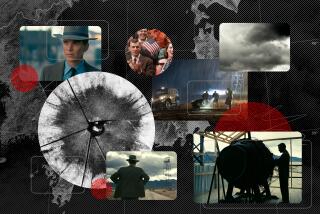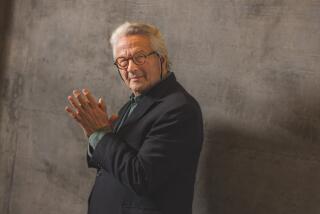Jon Jerde
In the continuing public debate about urban design, there is much discombobulation: Are real cities growing or fading? Do suburbs and “edge cities” represent the savior of civilization or its nadir? Is the theme-park city, all spectacle and shine, necessarily more enticing than the grit and danger of an authentic urban fabric? As he has so often before, architect Jon A. Jerde encompasses both the oldest and the newest of theories, usually in the same sentence.
Jerde, 58, appears a study in contrasts. He describes humans as a herd, instinctively coming together, and he addresses architectural spaces as “experiences,” as if he is discussing an amusement-park ride. He talks about “re-lamping” cities--relighting and repopulating decaying urban cores--though he designed the apotheosis of suburban shopping centers, the Mall of America in Bloomington, Minn. He was grappling with ways of captivating visitors, pulling them in and holding on to them, long before Times Square burst forth as a modern-day paradigm. Jerde’s architecture is full of whistles and pinwheels, but it also possesses an innate feeling for social complexity.
After making a splash designing the Los Angeles Olympics in 1984, Jerde gained wider recognition with Horton Plaza in San Diego the next year. The city’s downtown was in sad decline when the six-block retail-office-hotel complex opened in 1985. Though many downtown malls had tried and failed to revitalize cities such as New Haven, Conn., and Detroit, Mich., Horton Plaza proved a remarkable success. Jerde designed what he describes as “a casbah-like, high-experience district of a city” that has remained popular to this day.
Jerde’s projects, it seems, just keep getting bigger. He created CityWalk for Universal City; conceived the Fremont Street Experience to resurrect Las Vegas’ waning downtown and also designed elements of the Bellagio resort; and dreamed up Canal City Hakata in Fukuoka, Japan, that nation’s largest privately developed real-estate project, as a fantasy mix of retail, offices and entertainment. Plans to “re-lamp” Kansas City and Salt Lake City are on the drawing board.
All these designs emanate from Jerde’s offices on the boardwalk in Venice, where he heads a 120-person architecture and design firm. The building is not too far from his home in Mandeville Canyon, where he lives with his wife, Janice Ambry, an architect, and their 5-year-old son, Oliver. He has four older children from earlier marriages.
The shiny new world Jerde is building seems to jibe with an increasingly popular urban sensibility: Surprise is fine, but hard edges are not. In a conversation at his offices just a few days ago, Jerde displayed surety whether the subject was Baron Haussmann’s Paris, the “intelligent complexity” required of a city or what constitutes a functioning downtown at the end of the 20th century. And he possessed a subtlety quite in contrast with the flamboyance of his work.
Question: Malls were built in many downtown areas and failed. They put a mall into New Haven; it didn’t work. What did you figure out with Horton Plaza in San Diego?
Answer: We put an “experience” into downtown San Diego.
When we did Horton, most people didn’t even know there was a downtown. Or, if they knew, they wouldn’t have known how to find it. It was completely off the map.
Downtown San Diego was the mayor’s invention. That was the big thing for mayors to try to do, to revitalize their downtowns, all of which had been abandoned in favor of the suburbs in the ‘50s and ‘60s. The mayor said, “Nobody is going to develop anything until they fix my downtown.”. . .
I had been the architect for a company that specialized in these retail shopping machines and had been trying to convince people for years to do something more. Nobody was paying attention. . . . [But the developer] called me up and said, “You can do it the way you want.”. . . My conception had always been to do a casbah-like, high-experience district of a city, particularly a city with some degree of density. It would be a fantastic place for people to be in, as Venice, Italy, is for visitors and citizens of Venice.
The project was to come up with a logic of human movement to get to it, through it, back around and so on. Having done that, it was to create almost a one-act, two-act, three-act, four-act sequence of chambers of experience. It was high variety, so people would be enchanted by moving through this place. It had bridges and platforms and terraces and all sorts of things no one had ever seen before in these types of environments. And, incidentally, you could buy stuff.
The main purpose was for it to be a place to go to be a human--out in the sun, Allison Silver is the editor of the Opinion section.
walking around, visiting other people, seeing spaces in ways that you would never normally see spaces.
It worked: The normal, really great shopping center, at a great location--say, at the crux of two big freeways--would absolutely guarantee 9 million people a year. A really, really, really great one might get 9 and a half million a year. Horton Plaza got 35 million people a year--in a burned-out downtown. So, the point was if you designed the human experience, it would serve the final purpose--to sell stuff--better than anything you could think of.
Q: So, now you are moving out of retail spaces and on to city streets.
A: It’s just a different venue. I’ve become known as an unusual solver of problems. I’ve been given lots of real kinky problems that people can’t figure out ways to solve, and we’ve solved ‘em.
Like Fremont Street in Las Vegas: It was the original heart of the gaming industry in Nevada. It was downtown Las Vegas, and there are nine resort-hotel-casinos there, most of them relatively new, or with a great deal of money put into them, and they were all about to fall right off the charts as all this extravaganza stuff was coming in on the third wave of Las Vegas, the [Mirage Resorts Chairman] Steve Wynn wave. You know, pyramids and pirates and all that stuff was just outshining the downtown by a huge amount. There was a tremendous investment in the Fremont Street zone. And they were trying to figure out a way to put it back on the map.
So, they brought me in to solve it. We came up with this idea of the world’s largest casino, of which Fremont Street’s the foyer. It’s this ever-changing experience of light, built off the lights that were already there. We added more to it.
Q: If you had a downtown in the center of any older, Rust Belt city, you could revitalize it as you did in San Diego?
A: San Diego was a pretty rustic project; that was 20 years ago. We have many more sophisticated things we can do now.
Q: So, no city is lost?
A: Not at all. I think cities’ moment in time is coming back up again because there’s this desire for urbanity. Suburbanites have finally gotten around to figuring out that the suburbs are boring.
Q: But studies show both suburbs and edge cities are growing.
A: Did you ever look at the population from 1900 to 1990? The population is increasing, like, tenfold every time you turn around. The population is getting bigger. Suburbs are growing because there’s more people.
But there is no question about the return to cities. This is definitely happening. There’s all kinds of great stories about cities coming back to life again. San Diego is a great example.
Right now, we know about Kansas City. It’s pretty much the old L.A. story: The cluster of office towers at one end, surrounded by freeways, and a bundle of beautiful, vacant brick buildings. It will come flying back to life again by inserting new housing, new streets, cultural events, parks, all kinds of things for the free use of the public. It will probably be the hottest part of metropolitan Kansas City, which has some very fancy suburbs and satellite settings.
Q: If you were the design czar of Los Angeles, with power of eminent domain, how would you revitalize its downtown?
A: Ours is more difficult. . . . L.A. is such a vast place, it’s a grid that goes off the edges in every which direction. So, the idea of downtown itself is kind of an oxymoron. There is no such thing: There are many, many downtowns. . . .
In our downtown, you have it emphasize its own independent “place” characteristics: Just like Santa Monica has its own “place” characteristics and Pasadena has its, downtown still stays in a kind of old-fashioned, “downtown” state.
What has happened is what’s happened in many downtowns: the suburban exodus, where people just left. So, the only thing left . . . is office buildings.
To make our downtown work, bustling with people and things going on at night, would be to bring back housing, downtown or adjacent to it. So people can live there: It’s not just a place to come to work in and then leave.
Probably L.A.’s greatest asset is our tremendous ethnic population. And what we already have, entwining with the downtown and all around it, are some of the greatest existing theme parks you ever saw. There’s a Chinatown. There’s a Little Tokyo and Olvera Street. There’s all these wonderful things that are all standard one-liners. They’re all sort of separate, but they could easily be linked, woven into the downtown. So people that would be the users of these attractions, these districts, would now become the inhabitants and users of the downtown.
The stadiums and so forth coming into proximity would also be a tremendous help. We’ll see, ultimately, what’s going to happen. But it’s going to be tremendously useful in relighting our downtown.
The big point is, there’s life yet left in downtown Los Angeles. It’s not to be written off. It’s just a matter of other agendas getting done, a sort of ossifying. The last piece of untouched land is about to get built, with the Playa Vista project. So, that means they’re going to go back in [to the downtown] with much more finer grain and use the land that exists.
Q: One favored theory now is using the arts as a rejuvenating factor for cities. When you look back, the original Civic Center was partly about that. Now, planners are talking about renovating the downtown movie theaters. Are the arts the way to go?
A: It’s a way to go, not the way to go, particularly in a city as vast as Los Angeles. You see, a city works for many purposes, not just a popular, cultural purpose, or not just a daytime business purpose, but rather a conflicting, intertwining set of purposes: tourists and visitors and city residents and cultural things.
I created a group called UDAC--the Urban Design Advisory Coalition. And the whole purpose of it was to decode L.A. Because if this question was a Boston question, or anywhere else,the answers would be simple and easy. In L.A., it’s impossible to decipher the question, much less the answer. It’s a very elusive place.
One reason is that L.A. is really a teenager. The fact that it’s gotten blown way out of proportion in terms of the numbers of people and so forth makes it look like a heavy-duty city. But the fact is, it’s a punk. It hasn’t learned how to be itself yet.
Time will go a tremendous amount toward the re-lamping of downtown, if you will. Everything they’re doing is exactly right. They’ve kept the museums--the Temporary Contemporary [now the Geffen Contemporary] and then MOCA--downtown. The new Disney Hall is fantastic. Of all the places in this whole metropolitan zone, the only one where you can get that stuff is downtown.
I think Bunker Hill Towers, which was a sad experiment, is not sad anymore. It’s now a place that’s filled. . . .
There’s that whole national sense of moving back to downtowns. Half the projects we have right now, we’re relighting downtowns: Kansas City, Salt Lake City, Hartford, Conn. These were downtowns that were pretty much abandoned, and they’re now coming back on-line. They’re being seen as the greatest part of the whole city, as opposed to the unwanted or forgotten part.
Q: But cities were often about unlike people rubbing up against each other. There’s that danger factor, the surprise factor. Part of what you talk about is getting the danger out. You talk about safe.
A: No, you talk about safe. The people who talk about safe are my clients, not me. . . . [CityWalk] was commissioned by a private company. It’s a private company’s accessory to itself. It’s not a public place.
Q: But some people act as if they’re substitutions for a city.
A: I’m glad someone is asking me this: I don’t make these places private. I don’t make them safe. I just make them great. It’s up to somebody else to do all that other stuff.
Q: You talk about the urban fabric. But your projects are being used to replicate life in controlled private spaces. Do you think something is being lost in our society?
A: Yeah. But there aren’t any great cities that are, by their own nature, being formed now. Right now, it’s all private sector, not public sector. Private-sector concerns building something for a specific purpose. It’s not a city, it’s a thing.
CityWalk is an entertainment street. There’s nothing but cinemas, for the major part, and restaurants and a small degree of shops. It’s an entertainment place you go to. It’s disconnected entirely from the city at large because it sits at the top of a hill, with many hundreds of feet elevation between the bottom of the hill and the top of the hill--and nothing between except for studios. It’s bound on one side by the Los Angeles River, the other side by the Harbor Freeway, the other by the beginnings of the Barham Pass Mountains and the other by the Hollywood Freeway. It’s an island of separateness from the city and will always be. . . .
Q: Is building in Asia different from building in the United States?
A: I had to leave America to get built what I’d been trying to get built: complex, exciting cities. Nobody would listen here.
My very first client in Asia built the biggest privately created project in all of Japan, and it’s a gigantic success. It’s a new district of a city. It has just about everything in it, housing and hotels. It has all the things I hoped for it: captivating environments, variety and change and surprise. . . .
All they want me to do here is shopping centers--kind of a one-liner. I don’t mean to demean shopping . . . , but there are millions of people in your grasp, and all you’re doing is selling them stuff. You can entertain them, give them funny things to do they hadn’t thought about, build complexity into it.*
More to Read
The biggest entertainment stories
Get our big stories about Hollywood, film, television, music, arts, culture and more right in your inbox as soon as they publish.
You may occasionally receive promotional content from the Los Angeles Times.






